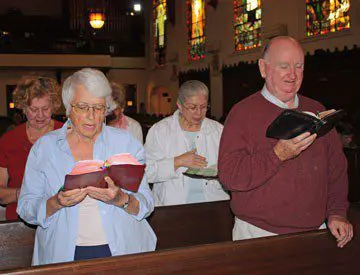
Recovering the Rhythm of Daily Prayer
Long ago, our ancestors in faith lived lives deeply rooted in daily prayer. Individuals and households praised and thanked God with a poetic richness expressed through morning and evening hymns and psalms—often known by heart. Over time, many of these practices faded. In more recent centuries, some new daily devotions emerged: the Morning Offering, the Act of Contrition, the Angelus, and other prayers tied to the rhythm of the day. But even these, for many, have now disappeared—leaving behind little to replace them.
A Loss Beyond the Mass
A similar decline has affected other forms of ritual prayer outside the Mass. For generations, Catholics turned to popular devotions—honoring the Sacred Heart, the Sorrowful Mother, and the saints. These prayers often filled the spiritual gap left when the liturgy was distant or inaccessible. Rooted in the language and culture of the people, they included hymns, gestures, incense, and sacred images. These gatherings were vibrant and deeply loved—but today, participation in such devotions has greatly diminished.
It was through these non-eucharistic practices that Catholics once learned how to pray—individually, as families, and in small communities. But now, for many Catholics, the Eucharist is the only shared form of prayer they know. Without other regular rituals—daily habits of praise, petition, thanksgiving, and contrition—we lack both preparation for the Eucharist and a way for it to echo through the rest of our week. In many parishes today, there is simply no structure to support communal prayer outside of Sunday Mass.
We Learn to Pray by Praying
Prayer is not just taught—it is caught through experience and repetition. We learn to pray the Eucharist by practicing other forms of ritual prayer in daily life. Without this practice, we risk becoming strangers to communal prayer itself.
Rediscovering forms and rhythms of prayer that speak to people today is not just helpful—it is essential.
The Liturgy of the Hours: A Forgotten Treasure
One path forward is the Liturgy of the Hours. This doesn’t mean expecting every layperson to take up the full breviary—the complex and lengthy prayerbook traditionally used by clergy and religious. In fact, the breviary is the result of a long development that began with the simple prayer of the whole Church.
In the early Church, before monastic elaboration, the Liturgy of the Hours was a natural part of Christian life—morning and evening prayer offered in common. Today, some are rediscovering those roots and seeking to recover the best of those early forms. A truly popular form of morning and evening prayer—simple, regular, and accessible—may once again become the heartbeat of parish and personal spirituality.
A Simple Path to Daily Prayer
In its simplest form, daily prayer need not be written down. It can be prayer of the heart, grounded in memory and rhythm. Core elements might include:
-
The Lord’s Prayer
-
Short intercessions
-
One or two psalms
These prayers bear repetition and can sustain daily use in a way most spontaneous texts cannot. For individuals, morning or evening prayer might include a psalm and a time of silence or reflection. For families or small groups, simple hymns and shared intercessions can be added. In parishes, gatherings on Sunday afternoons, Lenten evenings, or holy days might include a slightly fuller form, with scripture readings and music.
Rites of Prayer for Everyday Life
To strengthen our daily living of faith, we need simple, stable patterns of prayer—rites of prayer—that take root in our everyday routines:
-
Upon waking or preparing for the day
-
When gathering at the table
-
Before going to sleep
-
As a parish between one Sunday Eucharist and the next
These do not need to be invented from scratch. They already exist. Jesus knew them. They live in the Psalms, in our Scriptures, and in the long memory of the Church. Our task today is not to create something new, but to rediscover the treasure we already possess—and to let it shape our lives once again.
